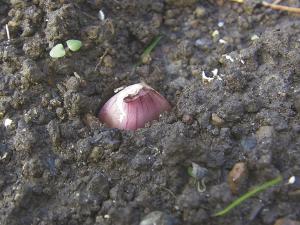Fall is the best time to plant garlic
America has traffic circles but Boston has rotaries. America has milkshakes and Boston has frappes. America has drinking fountains and Boston has bubblers. But Boston also has the infamous Boston accent. Accents are a funny thing. We all talk funny, as least to each other. The strong Boston accent is notable today among Italian and Irish working class neighborhoods. Dropping the “r” from words is technically called non-rhotic accent so car becomes “cah” and yard becomes “yaad.”
Our friend’s irascible son David has an uncanny ability to imitate the thick New England accent of his Italian grandmother. So garlic becomes “gah-lick.”
But whether it’s with an “r” or without, fall is the time to plant garlic. There are some real advantages over spring planting with warmer soil that lets roots grow right up until the ground freezes. You have several weeks for fall planting before the ground freezes solid.
Carefully break apart each garlic bulb into individual cloves. Try to keep the papery skins covering each clove from getting torn. To prevent fungus growth some gardeners presoak the garlic bulbs in a mix of a quart of water, mixed with a tablespoon of baking soda and a tablespoon of liquid seaweed. Soak your cloves in this water mixture for about two hours before planting.
Choose a garden spot with deep, rich, well-drained soil. Garlic prefers a neutral soil with a pH between 6.5 and 7.0.
Dig a trench three inches deep in rows a foot apart. Or you can plant garlic in a traditional circle with eight inches between each clove. Plant the cloves with the pointed end up. Cover the newly planted garlic with two to three inches of soil and tamp it down firmly. Soak the rows well with water. To prevent heaving of the bulbs over the winter, cover the rows with a good organic mulch of leaves or straw about six to eight inches deep.
That’s all you need to do. The garlic will send out roots and then go dormant during the winter. In early spring as soon as the soil has warmed up your garlic will sprout with grassy spikes and begin to grow.
There are two main types of garlic to grow in your garden: softneck and hardneck garlic. The softneck types (Allium sativum variety sativum) do best in mild winter areas and can often tolerate some cold. Softneck types are, as the name implies, good for braiding.
Softneck varieties store better than hardneck varieties, so grow these for long-term storage.
Hardneck Garlic varieties (Allium sativum var. ophioscorodon) are usually hardier than softneck varieties. These are the best to plant if you get harsh winters, though they do well anywhere it snows. Hardneck garlic also has the added benefit of growing garlic scapes or the central stalk that shoots up in spring. Garlic scapes can be used just like green onions with a pronounced garlic flavor. Hardneck varieties grow fewer cloves per bulb than softneck varieties, but the bulbs tend to be larger. Whichever variety you choose to grow, nothing could be easier than putting some garlic cloves into the ground, sitting back and waiting for them to sprout ad grow next year.
You may just grow something that is, as they say in Boston, wicked good.














































